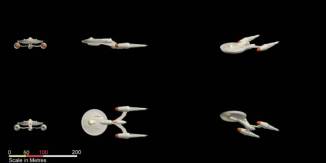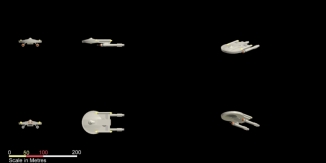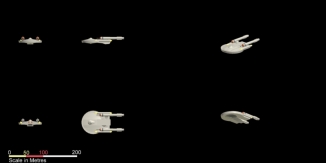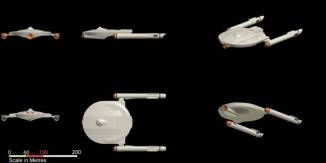In the late 2240’s a need was identified for smaller combatants which were designed to be extremely fast, well-armed, stealthy, and inexpensive to construct and operate. To meet this need, two different classes were proposed, the long range, powerfully armed, twin-nacelled Avenger class, and shorter ranged, less powerfully armed, single-nacelle Predator class. In total the requirement was for one hundred ships of each design to be built at yards throughout the Federation. A number of new technologies developed for the Constitution and Pyotr Velikiy classes were to be used in these new classes, out notably including a scaled down version of the Pyotr Velikiy’s main sensor suite.
Design work on Avenger and Predator in late 2250. Although a smaller design, the configuration of the Predator was much like that of the physically larger Hermes/Saladin class of the 2240’s.
The warp power plant for both of new ships was the new FWB-1 warp drive, coupled to the powerful FIB3 Impulse drive. The use of the same drive systems across both design resulted in further construction and cost efficiencies, and also led to the ships being provided with a good blend of power and manoeuvrability.
The primary hulls of both classes were nearly identical, and were 77-m in diameter. The primary hulls held the bridge, the M1 computer core, crew quarters, life support machinery, and cargo holds. The hull’s dorsal bulge housed the twin accelerator cannons (FAC3 on both designs. Unlike the larger Constitution and Pyotr Velikiy classes the bridge module was slightly submerged and slightly forward of the hull’s centre. Mounted either side of the bridge were emitters for the FSF shield system, these were mounted in this unconventional external position because of the small size of the hull. The rear of the primary hull housed the shuttlecraft bay, which extended along the connecting dorsal. Embedded in the rim of the primary hull was an emission suppression system which formed a key part of the stealth capabilities of the designs.
To the rear of the primary hull was a thick, deep connecting dorsal structure. In Avenger, the neck held the FIB3 impulse drive, and deuterium tanks. Beneath the neck was the small secondary hull mounting the FWB1 warp system with the distinctive Bulldog warp nacelles attached to either side. In Predator, the connecting dorsal was occupied mainly by engineering spaces for the impulse deck, the FWB1 warp drive connecting directly to the single centerline Bulldog warp nacelle. The single engine configuration of the Predator decreased the range and maximum warp speed but improved performance at impulse.
The the large numbers of ships ordered meant that construction was shared among six shipyards throughout the Federation, despite this all ships were built to the same exacting standards with many important subsystems manufactured at Mars and shipped to the yards for assembly. The six yards competed to construct ships most quickly or with the fewest flaws, the best performance being that of Andor’s Shesshik 7 facility which assembled and launched USS Drummer (NCC-D124) in 22 days.
USS Predator (NCC-D200) commissioned in early 2252, with USS Avenger (NCC-D100) following late the same year. Both classes immediately found use in a wide range of roles. In many cases they were used for policing duties, including anti smuggling and piracy patrols. Such actions freed larger ships, such as those of the Valley Forge, Constitution, and Pyotr Velikiy classes for duties in the burgeoning four years war. These ships were also used in a defensive role in areas away from the Klingon frontier, again to release larger combatants for service elsewhere. The Avenger class in particular also saw military usage in the Klingon theatre of operations.
Post war these ships were occasionally based at the borders of Federation territory in a pure defensive role, but more frequently they used to lead and escort survey, mining and colonisation vessels following in the wake of Starfleet heavy cruisers. The latter part of the war saw many these ships rearmed with FH2 phasers and FP1 photon torpedoes, which effectively doubled the combat efficiency of both designs.
A definitive refit program in 2258 saw the adoption of the new FWB2 in both designs, further improving performance and giving these classes an appreciable boost in available power.
To their crews and to Starfleet, the Avenger and Predator classes truly lived up to the description applied to a class of destroyer 300 years ago on Earth: “magnificent in appearance, majestic in movement, menacing in disposition.” These destroyers continued to serve in Starfleet until 2302, following life-extension refits in the early 2280s.
The Avenger-class destroyer USS Matador (NCC-D141) and the Predator-class destroyer USS Berserker (NCC-D208) are on display at the Starfleet Museum.
- Class: VI
- Year: 2252
- Ship Source: Starfleet Museum
- Ship Datasheet: Download PDF

Commissioned Ships
USS Predator NCC-D200
USS Aggressor NCC-D201
USS Ambusher NCC-D202
USS Annihilator NCC-D203
USS Archer NCC-D204
USS Attacker NCC-D205
USS Basher NCC-D206
USS Battler NCC-D207
USS Berserker NCC-D208
USS Biter NCC-D209
USS Blaster NCC-D210
USS Blazer NCC-D211
USS Blocker NCC-D212
USS Bombardier NCC-D213
USS Boomer NCC-D214
USS Brawler NCC-D215
USS Breaker NCC-D216
USS Bruiser NCC-D217
USS Buccaneer NCC-D218
USS Cannoneer NCC-D219
USS Charger NCC-D220
USS Charioteer NCC-D221
USS Chevalier NCC-D222
USS Conqueror NCC-D223
USS Crusader NCC-D224
USS Crusher NCC-D225
USS Cuirassier NCC-D226
USS Devastator NCC-D227
USS Disrupter NCC-D228
USS Dominator NCC-D229
USS Enforcer NCC-D230
USS Executor NCC-D231
USS Fencer NCC-D232
USS Fighter NCC-D233
USS Freebooter NCC-D234
USS Gladiator NCC-D235
USS Grenadier NCC-D236
USS Growler NCC-D237
USS Gunner NCC-D238
USS Hunter NCC-D239
USS Hurler NCC-D240
USS Hussar NCC-D241
USS Infiltrator NCC-D242
USS Interceptor NCC-D243
USS Intimidator NCC-D244
USS Invader NCC-D245
USS Jäger NCC-D246
USS Jouster NCC-D247
USS Lancer NCC-D248
USS Marauder NCC-D249
USS Mauler NCC-D250
USS Musketeer NCC-D251
USS Persecutor NCC-D252
USS Preserver NCC-D253
USS Privateer NCC-D254
USS Provocateur NCC-D255
USS Punisher NCC-D256
USS Pursuer NCC-D257
USS Raider NCC-D258
USS Ranger NCC-D259
USS Raptor NCC-D260
USS Rattler NCC-D261
USS Ravager NCC-D262
USS Resister NCC-D263
USS Rocketeer NCC-D264
USS Roughrider NCC-D265
USS Sapper NCC-D266
USS Scorcher NCC-D267
USS Sharpshooter NCC-D268
USS Sidewinder NCC-D269
USS Signaller NCC-D270
USS Skirmisher NCC-D271
USS Slasher NCC-D272
USS Slayer NCC-D273
USS Slinger NCC-D274
USS Smasher NCC-D275
USS Smiter NCC-D276
USS Snapper NCC-D277
USS Sniper NCC-D278
USS Spanker NCC-D279
USS Spiker NCC-D280
USS Spoiler NCC-D281
USS Stalker NCC-D282
USS Stinger NCC-D283
USS Striker NCC-D284
USS Terminator NCC-D285
USS Thrasher NCC-D286
USS Thriller NCC-D287
USS Thruster NCC-D288
USS Thumper NCC-D289
USS Thunderer NCC-D290
USS Tormentor NCC-D291
USS Trapper NCC-D292
USS Trooper NCC-D293
USS Trouncer NCC-D294
USS Usurper NCC-D295
USS Vanquisher NCC-D296
USS Vindicator NCC-D297
USS Warrior NCC-D298
USS Wrestler NCC-D299




















You must be logged in to post a comment.